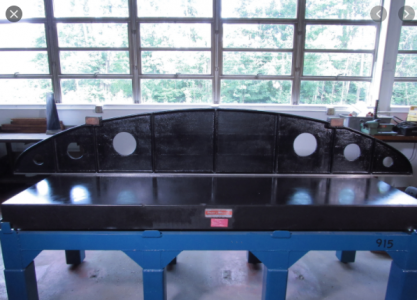Agreed that a 3m long straight flat, especially if as much as 75mm or 100mm wide is a reference to be taken care of - and cutting it is bound to rub the wrong way among those who appreciated what it took to get that way. An extreme version of "parting out". If another fabulous antique cartographer's atlas is discovered, it's fate is to be unbound, and the pages sold as separates. I guess humans are like that.
For the hobbyist, even a short straight edge reference is really expensive! Just a raw rough casting for a 12" little camel-back is
£165 ($217). A used 18"x1.5"x 3" ex Brown & Sharpe is
£485 ($637). I can fully understand the motivations of guys like Alex (the fabricator) to go against the traditional ways. He made it for a press-break, which may not need to be as accurate as might be needed for, say, lathe ways. Even so, everything he did to indicate measure it, and what he did with it seems sane.
Traditionally, a particular type of cast iron is used because it is known to be very stable. Support castings shapes, with motive to keep the weight down, became received wisdom from the beginning. If Alex found a steel structure that compensated such as to match the performance of the traditional build, then good for him!
In a different application I knew that carbon fibre composites had exceptional stability. It had me thinking that maybe a carbon fibre support structure under a final scraped metal surface could be stable. Unfortunately, the temperature coefficient of carbon composite, while well enough constant for a given single layup build , can be chosen over a fairly wide range, and pretty much all are considerably less than for cast iron. Even then, making it that way is unlikely to be cheaper than the traditional way - though possibly much lighter.
Likely there is no comparative critical study that would give us a clue as to exactly how good is the Alex fabricated SE, compared to the, by now very well known, performance of traditional cast iron standards. His SE was knocked up in a hurry, used, and then stored for 2 years before he made the video. Maybe, if a USA-based HM member brought one to one of
@Richard King 2 's classes, it could be spotted against something known.
Alternatively, just build one and keep a check using a surface plate.
We still need all the skills and effort and time to get it flat as taught by Richard, and a laser-cut support + two chunks of carbon steel, plus welding and scraping effort is not doing it on the cheap. This kind of accuracy always costs, and these skills are still around as a labour of love. My dabbling with actual scraping is likely to be limited. Getting to acquire the references is first. Only then I might get to scrape on the stuff that really needs it.


